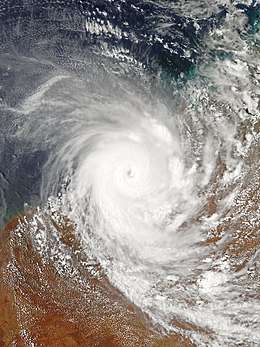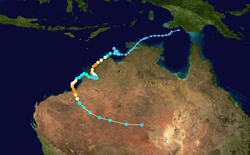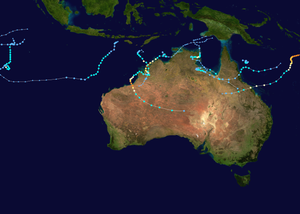Cyclone Laurence
Severe Tropical Cyclone Laurence of December 2009 was the first Category 5 tropical cyclone to make landfall in Australia, since Cyclone George in 2007.
| Category 5 severe tropical cyclone (Aus scale) | |
|---|---|
| Category 4 tropical cyclone (SSHWS) | |
 Cyclone Laurence at peak intensity on 21 December | |
| Formed | 8 December 2009 |
| Dissipated | 23 December 2009 |
| Highest winds | 10-minute sustained: 205 km/h (125 mph) 1-minute sustained: 240 km/h (150 mph) Gusts: 285 km/h (180 mph) |
| Lowest pressure | 925 hPa (mbar); 27.32 inHg |
| Fatalities | None reported |
| Damage | $9 million (2009 USD) |
| Areas affected | Northern Territory, South Australia and Western Australia |
| Part of the 2009–10 Australian region cyclone season | |
Meteorological history

Severe Tropical Cyclone Laurence was first identified by the Australian Bureau of Meteorology (BoM) on 8 December 2009 over the Arafura Sea.[1] As the system moved west north of the Top End on 10 December, TCWC Darwin issued a Tropical Cyclone Watch for coastal areas from Croker Island to Bathurst Island but excluding Darwin.[2] Later that day, TCWC Perth cancelled all previous warnings and issued new watches for Kalumburu, south to Wyndham and west to Mitchell Plateau.[3] The system hovered in the same general region for a day, before strengthening into a category one cyclone, and was named by the TCWC Darwin as Tropical Cyclone Laurence. During the morning of 15 December, the cyclone strengthened into a category 2 cyclone before strengthening further into a category 3 system.[4] In the early hours of 16 December Severe TC Laurence was upgraded to a strong category 4 with an eye starting to develop; later developing into a category 5 system.[5] The cyclone crossed the Kimberley coast southeast of Cockatoo Island on 16 December and Derby was in the projected path.[6]
On 17 December the cyclone weakened as it meandered over land dumping heavy rain over northern Kimberley. The cyclone's track during the day veered south-west and re-intensification was likely by 18 December as it moved over warm waters.[7] On 19 December, the storm re-intensified into a category one cyclone and began moving slowly southwest, and further intensified into a category 2 the same day.[8] On 20 December it intensified into a category 3 severe tropical cyclone, and showed signs of further intensification.[8] On 21 December, the cyclone rapidly intensified into a category 4, and then 5 by the afternoon. The cyclone made landfall on the Western Australia coast near Eighty Mile Beach as a category 5 storm with significant damage to structures reported, although no injuries have been reported. Telephone services to the affected area were disrupted.[9] Overnight, the system began moving inland and rapidly picking up speed, while gradually weakening into a category 3 tropical cyclone.[9] By early 23 December, the cyclone had weakened to Category 1 intensity, but not before inundating eastern Pilbara region with rain and flash flooding.[10] Laurence accelerated even further, and was expected to cause gale-force winds and flooding rain as far as South Australia.[8]
Preparations and impact
.jpg)
As a tropical low, the precursor to Laurence produced 250 mm (9.8 in) of rain in Darwin, Northern Territory in a 24-hour span.[11] One person was seriously injured after falling off a roof in the Kimberley, Western Australia.[12]
After making its final landfall along the Pilbara coastline as a Category 5 cyclone, Laurence wrought severe damage. Numerous trees were uprooted by wind gusts reaching 295 km/h (183 mph) and several homes sustained substantial damage. Rainfall in the region was estimated to have exceeded 250 mm (9.8 in). Power and phone service to most of the Pilbara was lost during the storm and several residents sought shelter in public buildings.[13] Although no people were killed by the storm, hundreds of livestock were feared to have been killed in the affected region.[14]
Heavy rain and gale-force winds associated with the cyclone forced the closure of Newcrest Mining Ltd's Telfer gold mine for a day as all non-essential workers were flown from the site.[10]
New South Wales' river systems were put on flood alert as rain fell widely. Systems affected were:
- Castlereagh River,
- Bogan River,
- Lower Namoi River, and
- Lower Macquarie Rivers, and
- the Barwon River and associated Darling River between Walgett and Bourke.[15]
The name Laurence was retired. It was replaced with Lincoln
Damage from the storm amounted to A$10 million (US$9 million).[16]
References
- Linda Paterson (19 May 2010). "Severe Tropical Cyclone Laurence" (PDF). Perth Tropical Cyclone Warning Centre. Australian Bureau of Meteorology. Retrieved 25 December 2010.
- Cavanagh, Rebekah (11 December 2009). "NT coast on cyclone watch". Northern Territory News. Darwin. Archived from the original on 20 September 2016. Retrieved 11 December 2009.
- Forecast Track, 2009-12-11, 0728z
- Technical Bulletin 13 December
- Technical Bulletin 16 December
- "Angry Cyclone Laurence category 4, lashing coast with 260km/h winds". Perth Now. Perth: AAP. 16 December 2009. Archived from the original on 2 October 2011. Retrieved 16 December 2009.
- "Cyclone Laurence losing power, but could 're-intensify'". Perth Now. Perth: AAP. 18 December 2009. Archived from the original on 2 October 2011. Retrieved 18 December 2009.
- https://web.archive.org/web/20081225082114/http://www.bom.gov.au/products/IDW60281.shtml
- "Archived copy". Archived from the original on 20 January 2010. Retrieved 3 February 2009.CS1 maint: archived copy as title (link)
- Cordingly, Geoff (22 December 2009). "Homes damaged as Cyclone Laurence crosses coast". Perth Now. Perth: AAP. Archived from the original on 2 October 2011. Retrieved 23 December 2009.
- "AIR Analyzes Impact of Tropical Storm Laurence on Western Australia". AIR Worldwide. 17 December 2009. Retrieved 18 December 2009.
- "Man injured during Cyclone Laurence". The Sydney Morning Herald. 17 December 2009. Retrieved 20 February 2011.
- "Cyclone Laurence leaves a trail of damage in the Pilbara". The Sydney Morning Herald. Associated Press. 23 December 2009. Retrieved 23 December 2009.
- "Cyclone Laurence lashes western Australia". Agence-France Presse. 23 December 2009. Archived from the original on 22 December 2009. Retrieved 23 December 2009.
- NSW flood warning in wake of cyclone, ABC Online, 24 December 2009
- "Archived copy" (PDF). Archived from the original (PDF) on 27 September 2011. Retrieved 25 March 2015.CS1 maint: archived copy as title (link)
External links
| Wikimedia Commons has media related to Tropical Cyclone Laurence (2009). |
- Joint Typhoon Warning Center (JTWC)
- Australian Bureau of Meteorology (TCWC's Perth, Darwin & Brisbane)
